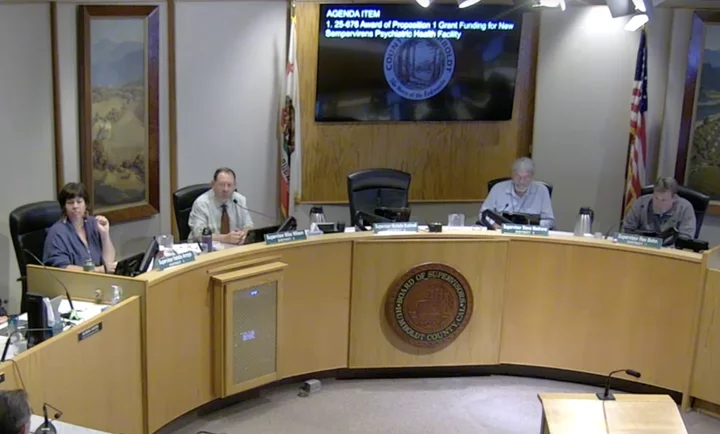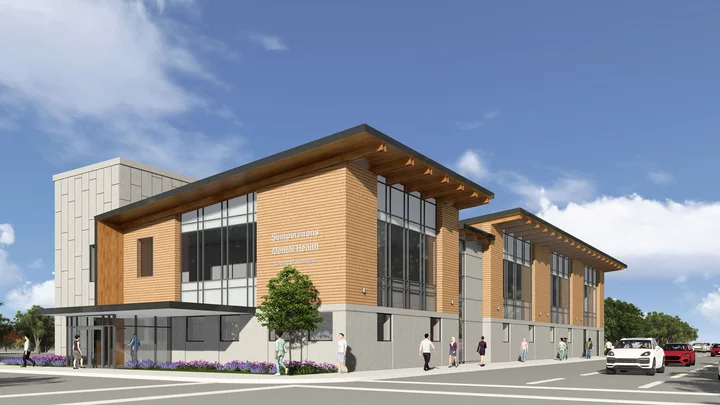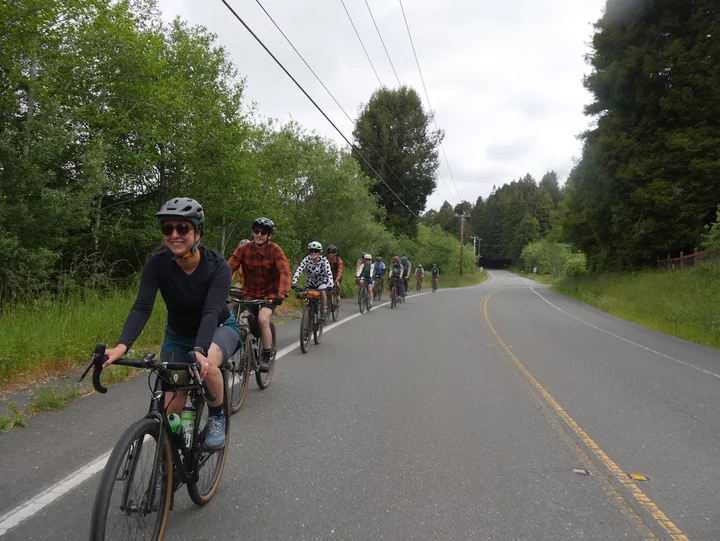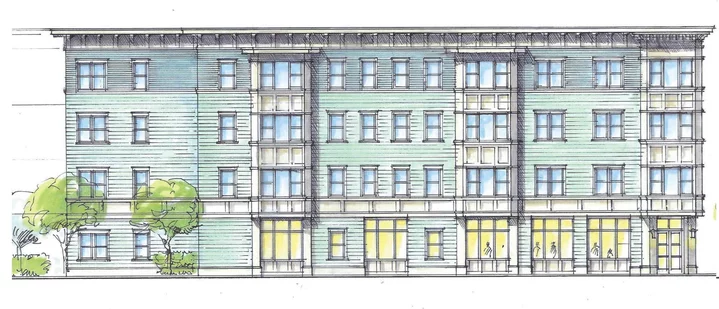Humboldt Supervisors Check Out Draft Plans for New Sempervirens Facility
Isabella Vanderheiden / Tuesday, June 10 @ 2:43 p.m. / Local Government
Screenshot of Tuesday’s Humboldt County Board of Supervisors meeting.
###
After securing $43.5 million in state grant funding last month, staff with the Humboldt County Department of Health and Human Services (DHHS) and Public Works are moving ahead with plans to relocate and rebuild Sempervirens Psychiatric Health Facility on a Fifth Street parking lot, directly across from the Humboldt County Courthouse in Eureka.
The new inpatient facility is slated for completion in 2030.
For nearly 60 years, the 16-bed facility has operated out of the Clark Complex, the former Humboldt General Hospital campus built in 1907. Over the years, the building has fallen into disrepair with structural issues that have put the facility’s operations at risk.
Speaking at today’s Humboldt County Board of Supervisors meeting, DHHS Director Connie Beck underscored the importance of the project, emphasizing that “there haven’t been any significant improvements made to the facility over the last 45 years.”
“From Fiscal Year 2021 through 2024, maintenance, repair and project costs have exceeded $864,000,” she continued. “There have been 3,008 work orders in [those] five years. We have approximately $4.1 million [in] projects that are currently on hold, including full elevator retrofitting, replacement of a leaky window, tile and floor repairs, etc. We have another $2 million in additional recommended repairs and upgrades. … I think most of your board is aware that the Grand Jury has reported on the current facility every year since [Fiscal Year 2019-20].”
Draft rendering of the new Sempervirens, as seen from Fifth and I streets in Eureka. | Image: County of Humboldt
Plans for the new 21,000-square-foot facility include 16 inpatient beds, four crisis stabilization unit beds and expanded access for children and youth, as well as patients who are not ambulatory. Surely anticipating questions about expanding, Beck noted that Sempervirens is only permitted for 16 inpatient beds, due to federal rules surrounding Medicaid- and Medicare-certified facilities.
The $43.5 million grant was awarded through Proposition 1, the Behavioral Health Services Act, passed by California voters in March 2024 to replace the Mental Health Services Act of 2004. After the county was notified of the conditional grant award in early May, staff had just 10 days to submit plans for a shovel-ready project.
Over the next year, DHHS and Public Works staff will work with an outside consultant to finalize the design plans. On top of that, staff have yet to determine who will run the facility.
“We may contract with another entity, or possibly continue to run as the county,” Beck said. “I know your board is aware that we have several contracts with doctors and nurses in order to provide the services at Sempervirens. So, that will be a work in progress over the next couple of years.”
Fourth District Supervisor Natalie Arroyo asked if DHHS would be able to expand outpatient services at the new Sempervirens facility.
“It’s not going to be incorporated into this facility,” said Paul Bugnacki, deputy director of Humboldt County Behavioral Health. “We’re not sure where we’re going to put outpatient services yet. You know, we could possibly continue to use some of that space at 720 Wood Street … for outpatient services and substance use disorder services. … We would definitely need to have discussions about where those staff are going to reside.”
Beck noted that the Hope Center, located at 2933 H Street in Eureka, currently provides a variety of outpatient services. She added that the county could restructure some of the services offered at the Hope Center once the new Sempervirens is up and running. “There’s a whole lot here still that we have to figure out,” she said.
First District Supervisor Rex Bohn spoke in favor of the project but expressed concern for the extended timeline and potential for “a lot of hiccups in the next four years,” seemingly referring to the county’s budgetary woes and rising construction costs.
“I don’t see anything going down in the next four years,” he said. “This is exactly what happened … with the jail [expansion project]. We didn’t deposit the million dollars or whatever, so we got put on the back burner. … If we don’t get it built, costs are going to go up some more, and then it’s going to be unattainable and we’re going to be sitting here with a lot of wasted effort.”
Third District Supervisor and Vice-Chair Mike Wilson echoed Bohn’s concerns, but emphasized the “extreme” importance of the project. “It took tons and tons of hard work to have the established facility that we have today, but I have to say, it is on its last legs and we really need to move forward with something.”
Speaking during the public comment portion of today’s meeting, Public Works Director Tom Mattson underscored his support for the project. “Sometimes you have to take risks to get great rewards.”
“Make no mistake, this is a critical medical care facility,” Mattson continued. “Most people think about critical medical as, you know, the hospitals [and] regular doctors, [but] mental health is also very, very critical in our community. … We believe we built a solid budget that will survive what’s coming at us, but there’s always a risk.”
After some additional discussion, Fifth District Supervisor Steve Madrone made a motion to receive and file the report, which was seconded by Arroyo. The motion passed 4-0, with Board Chair Michelle Bushnell absent.
###
BOOKED
Today: 4 felonies, 8 misdemeanors, 0 infractions
JUDGED
Humboldt County Superior Court Calendar: Today
CHP REPORTS
4876-4879 Alder Point Blu Rd (RD office): Trfc Collision-1141 Enrt
ELSEWHERE
RHBB: Crash on Hwy 299 Temporarily Closed the Road, Three Children Involved
Governor’s Office: Governor Newsom signs tribal-state gaming compact 7.14.25
RHBB: Downtown Ukiah Evacuated After Contractor Strikes Gas Main
Governor’s Office: Governor Newsom signs legislation 7.14.25
15 Cyclists Rode to Every Murphy’s Market in a Day
Dezmond Remington / Tuesday, June 10 @ 7:32 a.m. / LoCO Sports!
The riders outside the Murphy’s in Sunny Brae (or maybe Glendale?). Photos by Kay Lopez.
On the other side of the Redwood Curtain, cycling is often associated with elitism and bicycles that cost triple what a used Honda Civic sells for and Fred-bashing Lycra enthusiasts with stringent sets of rules that define who, exactly, is a cycliste and who is a nerd with too much money. But to live in Humboldt is to do stupid things with, on, or to bicycles. Examples are abundant enough that providing them is almost pointless — take a look at the Arcata Plaza during Memorial Day weekend, or head out to the forest on a weekend and watch people throw themselves down hills and over berms and snake down evil singletrack switchbacks. Or perhaps ride in a great pack to every Murphy’s Market in the county.
It was May 25, 2025, and the weather was atypically fabulous. 15 cyclists descended on the Murphy’s Market in Sunny Brae sometime that morning, said some greetings, and started riding south. Their destination was another one of the local chain grocery stores, the Cutten location, and after that they were riding to the other Murphy’s in Arcata, then up to Trinidad, where they would make a pitstop at — shocker incoming — the one up there. Then a quick jaunt to sample what the Murphy’s in Glendale has to offer (apparently, a pretty damn good hot bar) and finally back to Arcata. All in all, the trip was about 64 miles, managed to avoid any major hills, and went smoothly.
OK, but why?
“I mean, how could you say ‘no’ to hitting five different Murphy’s?” asked rider Claire Anderson during an interview with the Outpost. “It’s kind of the perfect way to do a long distance ride.”
And it was. Employees greeted the cyclists at every stop with snacks, sandwiches, Gatorade, encouragement, and, in Glendale, custom buttons, adorned with the outing’s official title: The Murphy’s Metric Century.
Daisy Schadlich, an organizer of the ride, had the idea to ride to all of the Murphy’s last year. It turned out her roommate had the same idea, and they got as far as planning the route out — and then her roommate had to move. The idea was scuttled. But Daisy’s friend Claire had thought it was an excellent plan, and they had to do it before Claire and her partner moved away too, so they picked a weekend when they and their partners would be free.
At one point Daisy considered the Sunny Brae Murphy’s her “pantry,” often stopping in multiple times a day with her roommates because it was just around the block from her place. Sometimes she had to; sometimes it was an excuse to go out for a little while. She once had the pleasure of hooking a Scottish bikepacker up with his favorite soft drink from the Old Country on a trip to the Murphy’s. It had been discontinued back home — he was ecstatic.
Both Daisy and Claire are mainly mountain bikers, new-ish to the cult of the crankset. Claire started cycling about four years ago, Daisy about five. They met each other on a group chat made up of local women mountain bikers and became friends.
Humboldt’s brutal climbs and primeval roads can make two-wheeled transport difficult. Innumerable potholes and washboard dirt roads trash skinny road bike tires, and roads that offer endless miles of flat, car-free cruising are rare. Cyclists here tend to be tight.
“It’s incredible to me how the riding here is so hard,” Daisy said. “But people ride! It’s not even, like, these ‘weight weenies’ who are on these super tiny feather-light carbon bikes. You see people out there riding like whatever they have, and they’re stoked to see anyone else out there doing the same thing. And so I feel that’s kind of the mentality that we approach this. And, I mean, yeah, admittedly, I was wearing a full cycling kit, but I was also on my aluminum gravel bike, and wearing a Hawaiian shirt over the top.”
Races in Humboldt tend to emphasize the silliness of the task, of the impulse to power the machines over stupid distances and impassable obstacles, trails and avenues through beautiful scenery that rend and split metal and rubber apart piece by piece over infinite, infinitesimal repeated impacts. Bogstomp, a late-season cyclocross race in November out on a soggy chunk of land near Elk River, is an example par excellence of the ethos. There is no cell service. Competitors slip and slide all over steep, muddy hillsides while trying to complete laps. They must often get off of their bikes and walk them.
Daisy (left) and Kay Lopez pose with onions in the Trinidad market. Photographer unknown.
Basically, spending a day riding 100 kilometers to a chain of grocery stores isn’t unapproachably weird to a lot of folks. When Daisy hit the group chat up to pitch the ride, she found out that more than a few people had dreamed up the same ride independently. It wasn’t hard to bring together more than a dozen people who were in. But Daisy and Claire were the first to bring the idea to Murphy’s. They reached out to Kelsie Ng, the Marketing and Human Resources specialist for Murphy’s, to see if they could set something up.
Kelsie was enthusiastic about the idea. She thought it would be a good opportunity for friends to hang out with one another outdoors, and she liked the plan of hopping location-to-location. She sourced snacks and goody bags for the riders, and made special posters. She wanted to spectate, but was out of town that weekend and couldn’t.
While the peloton was trawling from one store to another, employees called one another to advise them of the groups ETA’s, and made a point of taking a photo of them in front of each store. When they arrived, they’d mess around a bit, eat, and take more pictures.
Daisy, Claire, and their partners knew most of the people who joined them on the ride, but there were a few new faces. A man they knew only as “Rusty,” who claimed to be a professional mountain biker with a pilot’s license, showed up in full cycling kit on a nice bike. He led the group for most of the day (seven and a half hours from start to finish, including breaks), and despite his pedigree, was down to just hang out and chat with everyone. Everyone was alright with getting strange. People posed with onions in the Trinidad market, and one person rode a giant steel bicycle, a behemoth-like beast that clocks in at almost 30 pounds named the “Surly Ogre.” But no one treated it like anything it wasn’t.
“We might be going a long, long way,” Claire said, “but it’s not a race.”
They plan on doing it again next year.
72 Hours in LA: Immigration Sweeps, Protests and a Historic National Guard Deployment
CalMatters Visuals Team / Tuesday, June 10 @ 7:13 a.m. / Sacramento
CalMatters photographers captured immigration sweeps and protests that led up to President Trump’s deployment of the National Guard to Los Angeles.
###
This story was originally published by CalMatters. Sign up for their newsletters.
###
Protesters filling the streets. Helicopters circling overhead. Tear gas smoke drifted in the air. The National Guard deployed in the nation’s second largest city despite the objections of the state’s governor.
After a series of immigration raids across the Los Angeles area, demonstrators gathered in various parts of the city to denounce the arrests. In some cases people threw rocks at authorities. Law enforcement’s response — including tear gas, arrests, and the deployment of troops — transformed the city into a flashpoint over immigration enforcement.
By Sunday, hundreds of National Guard troops patrolled a federal building on the orders of President Trump, who bypassed state leadership in calling up the soldiers.
Though peaceful at times, the protests were tense, and demonstrators were met with tear gas, “less lethal” projectiles and arrests. State and local officials condemned the deployment of the National Guard, with many urging protesters to demonstrate peacefully. Through it all, freelance photographers Ted Soqui and J.W. Hendricks covered the events for CalMatters. These are their photos.

Federal immigration authorities face off against protesters during an ICE raid at Ambiance Apparel in downtown Los Angeles on June 6, 2025. Photo by J.W. Hendricks for CalMatters


First: A person holds flash bang grenade canisters deployed by law enforcement during an immigration raid by Immigration and Customs Enforcement agents at the Ambiance Apparel clothing factory in Los Angeles’ Fashion District. Last: A crowd gathers near the clothing factory on June 6, 2025. Photo by Ted Soqui for CalMatters

Protesters march around the Metropolitan Detention Center in protest of an ICE raid earlier in the day on June 6, 2025. Photo by J.W. Hendricks by CalMatters

Protesters clash with police at the Metropolitan Detention Center in protest of an ICE raid earlier in the day on June 6, 2025. Photo by J.W. Hendricks by CalMatters


First: Police tape near the Ambiance Apparel clothing factory in Los Angeles’ Fashion District following an immigration raid by U.S. Immigration and Customs Enforcement on June 6, 2025. Last: Demonstrators protest against ICE immigration raids in downtown Los Angeles on June 8, 2025. Photo by Ted Soqui and J.W. Hendricks for CalMatters

Officers with the Los Angeles Sheriff’s Department fire “less lethal” munitions upon protesters in Compton on June 7, 2025. Photo by J.W. Hendricks for CalMatters

Protesters clash with officers of the Los Angeles Sheriff’s Department in Compton on June 7, 2025. Photo by J.W. Hendricks for CalMatters




First: An officer with the Los Angeles Sheriff’s Department puts out a fire in Compton on June 7, 2025. Second: A demonstrator carries rocks during a protest in downtown Los Angeles on June 8, 2025. Third: Police vehicles parked on the 101 freeway during a protest against ICE immigration raids in downtown Los Angeles on June 8, 2025. Last: California Highway Patrol troopers attempt to clear demonstrators from the 101 freeway in downtown Los Angeles on June 8, 2025. Photo by J.W. Hendricks and Ted Soqui for CalMatters

California National Guard soldiers stand with shields outside the Federal Detention Center in downtown Los Angeles, on June 8, 2025. Photo by Ted Soqui for CalMatters


Protesters demonstrate against ICE immigration raids and the deployment of the National Guard in downtown Los Angeles on June 8, 2025. Photo by Ted Soqui for CalMatters

Protesters demonstrate against immigration raids in Compton on June 7, 2025. Photo by J.W. Hendricks for CalMatters
California Democrats Choose Progressive Latina to Succeed Mike McGuire as Next State Senate Leader
Jeanne Kuang / Tuesday, June 10 @ 7 a.m. / Sacramento
State Sen. Monique Limón speaks before lawmakers during a Senate floor session at the state Capitol in Sacramento on Jan. 23, 2025. Photo by Fred Greaves for CalMatters
###
This story was originally published by CalMatters. Sign up for their newsletters.
###
On Monday, Democrats elected Sen. Monique Limón as the next leader of the California Senate, the first woman of color to hold the position.
A progressive whose major donors are California unions, Limón, from Santa Barbara, is known for pursuing pay transparency legislation, consumer protections such as shielding medical debt from credit reports and efforts to regulate the oil industry. She authored a 2022 law that requires setbacks around new oil and gas wells and steps to protect residents at old wells, and pushed for an unsuccessful 2021 bill to ban oil fracking. Gov. Gavin Newsom later ordered the ban.
Limón, 45, noted that she’s a daughter of immigrants and pointed to her election at a time when California is wrestling with an escalating showdown with the Trump administration over protests against deportations in Los Angeles.
“On the day where we are witnessing our California values being under attack, we are electing the first woman of color ever in history to serve in this role,” she said. “This is significant, it matters and we will move forward together.”
The Democratic lawmakers voted privately to elect her after weeks of murmurs about a challenge to Senate President Pro Tem Mike McGuire’s leadership that culminated over the weekend within Limón, the current caucus chair, securing a majority of supporters.
She will take over from McGuire next year, he told reporters in the Capitol with Limón and a majority of their Democratic colleagues standing beside him. They did not announce a formal transition date.
Notably absent was Sen. Lena Gonzalez, the Long Beach Democrat and Senate majority leader who was also reportedly bidding for the leadership position.
Generally, lawmakers can make a bid for leadership whenever they have enough support within the party. McGuire, who is termed out after 2026, had tried to head off the internal jockeying for his seat, telling Politico in late May that he intended to stay as leader through the end of his term.

State Sen. President Pro Tem Mike McGuire during a floor session at the state Capitol in Sacramento on April 24, 2025. Photo by Fred Greaves for CalMatters
The handoff was ultimately announced with copious amounts of mutual praise.
McGuire, a Healdsburg Democrat, said Limón’s experience representing a district affected by wildfires would serve the Senate well on fire safety and insurance issues. He also emphasized the historic nature of her election.
Unexpected timing amid Los Angeles protests
Limón acknowledged the timing of her bid was “not expected;” it came not only during the federal showdown in Los Angeles but also during a week when lawmakers face a deadline to pass a budget. She said the decision was “a matter of the caucus.”
Limón was elected to the Assembly in 2016 and the Senate in 2020. Like McGuire, she’ll serve a relatively short term as leader because she’s scheduled to leave office at the end of 2028.
Her district includes Santa Barbara County and the western, heavily agricultural portion of Ventura County. Like many California Democrats she’s backed heavily by unions, which are among her top campaign contributors. She voted in alignment with the Service Employees International Union’s positions on bills 93% of the time, according to the CalMatters Digital Democracy database. She took the position of the California Chamber of Commerce only about a quarter of the time.
Her leadership could also lead to further questions about bills designed to cut red tape and speed up housing construction. While the Assembly and Newsom have embraced those proposals, the Senate has been sharply divided on them this year.
Limón’s voting record indicates some opposition. She has declined to support some of the state’s most high-profile pro-development bills, SB 9, which allows single-family homeowners to turn their houses into duplexes, SB 423, which allows certain apartment buildings to avoid environmental review and this year’s SB 79, which is aimed at allowing denser development along major public transit corridors.
Prior to her election to the Legislature, Limón served six years on the Santa Barbara Unified School Board, was assistant director for the McNair Scholars Program at UC Santa Barbara and was a member of the Santa Barbara County Commission for Women.
###
CalMatters reporters Ryan Sabalow and Ben Christopher contributed to this story.
OBITUARY: Marvin Jones Sr., 1932-2025
LoCO Staff / Tuesday, June 10 @ 6:56 a.m. / Obits
Marvin Jones, Sr., said his final goodbyes to his family on March 14, 2025 at the age of 93. Marvin passed in the comfort of his own home, which was one of his strongest end-of-life wishes. There was rarely a time in his life that Marvin was without a dog or a cat sitting nearby, but since his faithful companion Buster had passed only a month earlier, our family took up that post to keep him company. It was his daughter, Kay, who was at his bedside at the end.
Our dad was born In Tacoma, Washington in 1932. He was the oldest of six kids. After his own father got sick, Marvin had to work to help the family, so his education ended at 8th grade. When he was 21, he was drafted into the Army where he served his required time of two years. Afterwards, Marvin worked in mills most of his life. We remember him coming home with black glue stuck on his pants for many years from working at a plywood mill. He also pulled green-chain, with Louisiana Pacific being his last place of employment. Millworkers went on strike in the 1980s, and although negotiations were not successful, Marvin never crossed the picket line. His mill employment ended at that time.
Marvin married Shirley Hammack when he was 20 and she was 16. They were married 71 years when Shirley passed away in 2023. Marvin is survived by all six of his children, Rhonda Scott, Marvin Jones, Jr, Thomas Jones, Susan Davidson, Kaylene McCurry, and Lavonne Cookman. He is also survived by four of his siblings: Donald Jones, Dale Jones, Delma Pfanensteil, and Leola Santsche.
Along with six children, Marvin’s decedents include twelve grandkids, 33 great-grandkids, and four great-great-grandkids. One great-granddaughter preceded him in death, all the others are surviving.
| Children | Grandchildren | Great-Grandchildren | Great-Great-Grandchildren |
|---|---|---|---|
| Rhonda (Craig Scott) | Vangie (Doug) | Kaylee, Savannah | Adie, Carson, Avyan |
| Mandee (Greg) | Carlee (Dale) | Scarlett | |
| Marvin, Jr/Bub | Marvin III (Esther) | Destanie | |
| Lori | Corey, Kaysea, Matthew, Joseph | ||
| Michelle | James, Annabelle, Makara, Terrell | ||
| Tommy (Kimmy) | Abby, Gracie | ||
| Tom | Christine | IIIII IIII | I |
| Susan (Bil Davidson) | Amiee | Ashley, Ty, CJ | |
| Kaylene McCurry | Valerie | ||
| Lavonne (Tom Cookman) | Stephanie (JW Brown) | Jordan, Malachi, Naomi | |
| Casey (Jasmin) | Samson, Shirley | ||
| Jimmy (Liesa) | Isaac, Zoe |
Marvin was an avid outdoorsman and loved to fish, hunt, pick wild blackberries, wild huckleberries, and anything that could be harvested and eaten. He boiled wild cattails for all of us kids to try. It turns out they taste a bit like corn on the cob. He was never without a pocket knife, and he often used it to hold a slice of apple he offered to us. Our dad loved to eat healthy meals. Homemade food from a garden or from what he hunted or shed was his favorite. Even though he had an amazing appetite and ate a lot, he stayed thin. If you asked him his secret, he would tell you, as if there were no secret: only eat when you’re hungry.
Dad hunted every season to help feed his family. In 1963, when he was 31 years old, he got one of the largest blacktail deer ever harvested when he hunted on public land in Zenia. It was 11-1/2” at the base of one of the antlers. To this day, there’s not a person who sees the horns that doesn’t comment on the massiveness of them. Some people even thought they might be elk horns. Dad was very proud of them.
Never a strict rule or law follower, Marv showed his rebellious side often. Dad seemed to believe laws were more like guidelines or suggestions. He thought it was fine to drive without a license or insurance. When he was 85, he went to the Fish and Game Department to buy his deer license and tags. In order to purchase, Fish and Game requires a previous license or a copy of the hunter’s safety certificate. Due to his age, he had never taken hunter’s safety, and he had misplaced his license. As a result, Fish and Game wouldn’t sell him a current season’s license and tags. Dad told us he stormed out of the office saying, “You just made a poacher out of me!” Stubbornly, dad did hunt that year by himself when he was 85, and he successfully harvested a buck. He came back home a happy criminal.
Marvin had a somewhat warped sense of humor, and he bellowed a giant, joyous laugh any time he pulled a prank on someone. He loved to scare his kids and grandkids. Often, when he was supposed to be watching kids, he would take the opportunity to sneak outside when they weren’t looking. He would then pull a nylon over his head to smash and distort his face and knock on a window where the kids were. After they looked outside, he’d shine a flashlight under his chin so his eyes and mouth looked like gaping dark holes. It terrified every kid and they ran away screaming when they saw a creepy man outside the window. He would then race back in the house from another door, asking what was wrong. Another favorite prank would be to find an unsuspecting victim sitting in a chair. He’d sneak in from behind, where he would dangle a fake spider in their face, and then he’d belly laugh after they screamed and swiped at the spider. He often laughed until tears rolled down his cheeks. His boisterous laughter will be missed.
Dad was very competitive. He enjoyed playing checkers and was a master. He preferred checkers to chess and taught many people that there is a lot of strategy to playing what seems like a simple game. Up to the final months of his life, he could still beat his caregivers, when he would set up many moves ahead, so he could trap his opponent and make double and triple jumps. Dad also loved horseshoes and bowling. He was the oldest man in Humboldt County to bowl a sanctioned 300 game during league play.
Dad loved all animals. We had pet turkeys, goats, cats, dogs, and rats. He used to drive our mom crazy when he’d save spiders or other insects from the firewood. One year, on a drive home from Oregon, unfortunately for our mom, he saw a sign, “Goats for sale.” He couldn’t resist the temptation. We stopped and ended up with a mama goat and another goat with a broken leg. Dad thought we could enjoy goat’s milk and also nurse another goat back to health. Both goats rode back to California for about three hours in the back seat of the car with four of us kids loving every minute. It didn’t bother us when the goats had to “go” on the floor or seat of the car. Dad was a rebel and didn’t care either. In the end, we kids had two friendly goats to play with. We eventually learned to milk a goat, and the milk turned out to be delicious.
Dad’s favorite pets were his dogs, and he took them for a walk on the beach every day for as long as he was able. Beaches, rivers, trees,and wildlife were a source of peace for him. He could name just about every tree or the type of wood something was made from. His son Tom says he can’t look at a tree and not search for the perfect branch to make into a sling shot, because that was something dad enjoyed doing. One of dad’s favorite possessions was his yew wood bow that he carved himself. He could shoot arrows from it that traveled as far as his compound bow. It was very impressive to watch.
Marvin loved to play the harmonica, which he did terribly and enthusiastically. He was always up for games of most any kind, including a game we introduced to him called cornhole. Similar to horseshoes but using bean bags to throw, he took to it quickly, even at the age of 87. Years earlier, when he was in his early 80s, shingles had attacked the nerves in his dominate right arm, both paralyzing it and making it painful to use. He had to learn to use his left arm for everything. So, even though he was 87 and using his non-dominate arm, he gleefully beat his 37-year-old granddaughter, Stephanie, while learning how to play cornhole. He also amazed us all when he rode a bicycle at the age of almost ninety. He was gifted with energy and athleticism, and he never wanted to slow down: Our dad had a zest for life.
Marv enjoyed phone calls from his brothers, even though his hearing loss made communicating difficult. His sister, Leola, visited him weekly. He looked forward to seeing her, and as long as they didn’t talk about politics, all was well. Any time someone came to visit, he was happy and social. As they were going out the door, his parting words were usually, “Watch out for the crazy drivers.”
Dad enjoyed going to Mad River Adult Day Health, and even attended there a few weeks before he passed. It seemed like an unknown final goodbye. The family would like to thank granddaughter, Valerie, and her friend, David, for their live-in care to Marvin during the last months of his life. We also appreciate Hospice of Humboldt’s care. We thank Vickie and Julie from the VA for all their dedication and commitment to dad’s health over the years. We also thanks Ayers Family Cremation for their kindness and service.
When dad could no longer read, he asked that the 23rd Psalm be read to him, and it clearly gave him comfort. Dad was a quiet Christian. Lavonne remembers when she was a child, asking our dad how she could know God was real if we couldn’t see Him. He answered with this: “You can’t see the wind, but you know it’s there. You feel it. God is the same.”
A private, end-of-life celebration was held at his home.
###
The obituary above was submitted on behalf of Marvin Jones Sr.’s loved ones. The Lost Coast Outpost runs obituaries of Humboldt County residents at no charge. See guidelines here.
Linc Housing Breaks Ground on Three New Affordable Apartment Projects in Eureka
LoCO Staff / Monday, June 9 @ 4:22 p.m. / Housing
Rendering of one of a new affordable apartment buildings under construction at Sunny and Myrtle avenues. | Submitted.
###
Press release from Linc Housing:
Nonprofit Linc Housing announced the start of construction on 90 new affordable apartments in downtown Eureka. The new homes are at three separate locations, making use of vacant city-owned land to bring much-needed housing to the area. The homes are for families earning 30-55% of the area median income.
The City of Eureka’s housing plan commits to developing at least 315 affordable homes to address the area’s housing shortage. This scattered-site development by Linc fulfills more than 25% of that commitment with its 90 new apartments.
“This development is more than just new buildings—it’s about restoring hope and opportunity for Eureka’s working families,” said Eureka Mayor Kim Bergel. “By prioritizing homes for those who need them most, we’re building a stronger, more resilient city that reflects our shared values and long-term vision for housing security and community well-being.”
The three new buildings include:
During predevelopment, Linc and the City of Eureka were awarded $30.1 million in Affordable Housing and Sustainable Communities (AHSC) funding from the California Department of Housing and Community Development. The funds will be used to support the construction and infrastructure of the three new apartment buildings, while fully funding new micro-transit vehicles, new bus shelters, bicycle parking, publicly accessible electric vehicle chargers, a bicycle lane along G Street, a trail connection from L to M streets, sidewalk repairs along Myrtle Avenue, a trail at Cooper Gulch, among many other upgrades and enhancements in the community.
- 550 M Street - northwest corner of 6th & M streets: 28 apartment homes, including 12 one-bedroom, seven two-bedroom, and nine three-bedroom units, a 1,988 square-foot courtyard on the ground-floor, and an 824 square-foot community room.
- 611 8th Street - northeast corner of 8th & G streets: 31 apartment homes, including 14 one-bedroom, eight two-bedroom, and nine three-bedroom units, a 2,244 square-foot courtyard on the ground floor, and a 774 square-foot community room.
- 1310 Myrtle Avenue - southeast corner of Sunny & Myrtle avenues: 31 apartment homes, including 16 one-bedroom, eight two-bedroom, and seven three-bedroom apartments, a 1,566 square-foot courtyard on the ground floor, and a 606 square-foot community room.
The AHSC funds will also support a workforce development program, an active transportation safety and encouragement program, a homelessness prevention and rapid rehousing program, as well as a no-cost transit pass program and a no-cost broadband internet program for residents of the three new apartment buildings.
“In addition to bringing 90 new homes to Eureka, this development includes more than $9 million in investment from the State of California for public transportation, bicycle and pedestrian improvements, and critical infrastructure citywide,” said Rebecca Clark, Linc Housing CEO. “It has been a long journey with our partners at the City of Eureka, and Linc appreciates their commitment to housing solutions that contribute to the overall wellbeing of the community.”
Funding for the development comes from a variety of sources, including multiple funding sources within the California Department of Housing and Community Development (AHSC, National Housing Trust Fund, Infill Infrastructure Grant), a construction loan from Umpqua Bank, a permanent loan from the California Community Reinvestment Corporation, as well as federal and state tax credit equity from the California Tax Credit Allocation Committee and investor Raymond James.
The buildings were designed by D33 Design and Planning, and the general contractor is Pacific Builders.
About Linc Housing Corporation Linc Housing, one of California’s leading nonprofit developers of affordable housing, is committed to building communities and strengthening neighborhoods for underserved populations. Linc has developed more than 10,0000 homes in 100 communities statewide. Known for its excellent design, outstanding management, and life-enhancing resident services, Linc has more than 40 years of experience serving families, seniors, individuals with special needs, and local governments. For more information, visit www.linchousing.org. To donate, visit www.linchousing.org/donate. To stay connected and join the conversation on social media, follow on Instagram @linchousing, LinkedIn Linc Housing and Facebook, and X (formerly Twitter) @LincHousing.
PREVIOUSLY
- The City of Eureka is Gearing Up to Turn Three More Parking Lots into Affordable Housing Developments, Including the Two Lots at City Hall
- Eureka City Council Releases Three City-Owned Parking Lots for Affordable Housing Developments; Adopts Budget for the Upcoming Fiscal Year
- Eureka City Council: Responding to Community Complaints Over Parking Lot Housing Developments, Staff Proposes Property Exchange With Pierson Company
- (UPDATE) Eureka Gets $30 Million Grant for Housing Projects That the ‘Housing For All’ Initiative Hopes to Block
- (UPDATE) Arkley-Affiliated ‘Citizens for a Better Eureka’ Files Two More Lawsuits Against the City, Aiming to Block Linc Housing Developments
- State Attorney General’s Office Joins the Fight Against the Pro-Parking Group ‘Citizens for a Better Eureka’
- ‘I Will Not Stand For It’: Attorney General Bonta Decries ‘Cynical’ Lawsuits From Citizens for a Better Eureka
- Judge Tosses Suit From ‘Citizens for a Better Eureka’ Backers Accusing the City of Violating Elections Code
- Linc Housing Secures Another $15M for 90 Affordable Housing Units in Three Eureka Locations
Attorney General Says Providence is Trying to ‘Shirk Its Duty’ to Follow the Law In Emergency Abortion Care Suit
Ryan Burns / Monday, June 9 @ 3:34 p.m. / Courts , Health Care
File photo
###
California Attorney General Rob Bonta is accusing Providence St. Joseph of trying to “shirk its duty to patients” under California’s Emergency Services Law, and on Thursday he filed a motion asking a judge to enforce an order requiring it to do so.
This is the latest motion in the state’s lawsuit against Providence St. Joseph, filed in September, accusing the Catholic-owned organization of violating multiple California laws through to its refusal to provide emergency abortion care to people experiencing obstetric emergencies.
The case focuses largely on the experiences of Eureka chiropractor Anna Nusslock, who is represented in a second suit filed by the National Women’s Law Center (NWLC). In response to the Attorney General’s latest motion, K.M. Bell, senior litigation counsel at NWLC and attorney for Dr. Nusslock, issued the following statement:
We applaud the Attorney General for continuing to hold Providence accountable for violating the law and endangering patients’ lives. The hospital cannot agree to follow state law in a court order and then walk away when it becomes inconvenient. Dr. Nusslock is still grappling with the trauma of being denied emergency abortion care, a violation that should never have happened in the first place. This motion is a crucial step in ensuring that hospitals in California are not permitted to disregard their legal obligations and prioritize ideology over patient safety. The law in California is clear: pregnant patients have the right to emergency care, including abortion. Providence Hospital must be held to its word and the law.
Below is a press release from Bonta’s office.
California Attorney General Rob Bonta today filed a motion to enforce the stipulation and order requiring Providence St. Joseph Hospital (Providence) to comply with state law. The motion to enforce comes after Providence signaled its intent to modify its stipulation and assert exceptions to their clear obligations under California’s Emergency Services Law (ESL). In September 2024, Attorney General Bonta filed a lawsuit against Providence alleging it violated multiple California laws due to its refusal to provide emergency abortion care to people experiencing obstetric emergencies. One particular patient, Anna Nusslock, had her water break when she was 15 weeks pregnant with twins on February 23, 2024. Despite the immediate threat to her life and health, and despite the fact her pregnancy was no longer viable, Providence refused to treat her. She had to travel to a small critical access hospital called Mad River, 12 miles away, where she was actively hemorrhaging by the time she was on the operating table.
“The terms of the stipulation and court order against Providence St. Joseph are clear. Providence must fully comply with California’s Emergency Services Law and ensure that patients can access life-saving health services including emergency abortion care – no exceptions,” said Attorney General Bonta. “Now, months after their stipulation and agreement to abide by the law, Providence St. Joseph is attempting to find wiggle room to shirk its duty to patients under the law. We refuse to let that happen. Even a single violation would be devastating, as no one should have to endure what Anna Nusslock and others experienced at Providence. We’re asking the court to enforce its order against Providence St. Joseph.”
To ensure that patients like Anna could receive timely emergency healthcare services, including abortion care, at Providence, Attorney General Bonta initially moved for a preliminary injunction in conjunction with the filing of the lawsuit. However, in October 2024, he secured a stipulation from Providence, enforceable by court order, to ensure the hospital followed California law while the case proceeds, with no exceptions or limitations. The stipulation resolved the Attorney General’s preliminary injunction motion, as Providence voluntarily agreed to comply with all the terms the Attorney General requested in its proposed injunction.
Now, seven months after entering the stipulation, Providence has asserted its intent to file a motion to modify the stipulation asserting that it does not require Providence to provide procedures to terminate a pregnancy that are prohibited by Ethical and Religious Directives. With this move, Providence is attempting to circumvent the unambiguous — and lawful — obligations it agreed to last year. Providence’s anticipated motion escalates a deeply concerning position: that the stipulation and order do not mean what they plainly state and that Providence only has to comply with them to an extent. Providence’s position raises grave concerns about the renewed risk of Providence violating the ESL and denying emergency abortion care. Therefore, Attorney General Bonta is asking the court to enforce its order and the unambiguous terms of the stipulation. Providence must follow the law and abide by ESL, without exception.
Under the stipulation and court order Providence must:
- Fully comply with California’s ESL, Health & Safety Code section 1317, et. seq. with respect to pregnant patients experiencing emergency medical conditions.
- Allow its physicians to terminate a patient’s pregnancy whenever the treating physicians determine in their professional judgment that failing to immediately terminate the pregnancy would be reasonably expected to place the patient’s health in serious jeopardy; result in serious impairment to the patient’s bodily functions; or result in serious dysfunction of any bodily organ or part of the patient.
- Comply with ESL’s pre-transfer treatment requirements. In particular, Providence Hospital may not transfer a pregnant patient without first providing emergency services and care (including where applicable terminating a pregnancy) such that there is a reasonable medical probability that the transfer or the delay caused by the transfer will not result in a material deterioration in the medical condition in, or jeopardy to, the patient’s medical condition or expected chances for recovery.
- Follow the policy and protocol requirements of the ESL under Health & Safety Code section 1317.2. In particular, Providence Hospital may not “discharge” patients with instructions to self-transport to another facility and Providence Hospital must comply will all applicable protocols and regulations for transfers prescribed by the California Department of Public Health.
A copy of the motion to enforce is available here.
###
And here’s a statement from a Providence spokesperson:
Serving the residents of Humboldt County is a privilege we, at Providence St. Joseph Hospital Eureka, don’t take for granted. That’s why we are wholeheartedly committed to providing high-quality, compassionate care, just as we have been for more than 100 years.
As a Catholic health care organization, we are transparent that we do not perform elective abortions. However, in emergencies, our care teams provide medically necessary interventions to protect pregnant patients who are miscarrying or facing serious life-threatening conditions.
This is consistent with the California Emergency Services Law and the Emergency Medical Treatment and Labor Act. It is also consistent with the Catholic Ethical and Religious Directives, which include discussion of the importance of the physician-patient relationship as well as the circumstances in which certain medical procedures that could result in fetal death may be allowed in a Catholic hospital.
The California Attorney General is interpreting the stipulation in a way that would require Providence to provide care that goes beyond the California Emergency Services Law and possibly in conflict with the Catholic Ethical and Religious Directives. Providence will address the California AG’s position in its forthcoming response through the litigation process.
We take our responsibility as a vital safety net incredibly seriously and are committed to continuing to meet the needs of our community, just as we have for more than a century.
###
PREVIOUSLY
- Attorney General Sues St. Joseph Hospital for Denying a Woman Emergency Abortion Care
- Providence Offers ‘Profound Apologies’ to Woman Denied Emergency Abortion Care at St. Joseph Hospital
- A Local Doctor Urged St. Joseph Hospital to Change Its Anti-Abortion Policies Long Before State Lawsuit, According to Court Declaration
- BREAKING: St. Joseph Hospital Denies Allegations in State Abortion Care Lawsuit But Agrees to Follow State Health Care Laws as the Case Proceeds
- Judge Signs Order Committing St. Joseph Hospital to Providing Emergency Abortions, At Least For the Duration of AG Lawsuit
- Citing Religious Freedom and Catholic Doctrine, St. Joseph Health Challenges State’s Emergency Abortion Care Lawsuit on a Variety of Legal Grounds
- State Responds to St. Joseph Health’s Attempt to Get Emergency Abortion Lawsuit Dismissed
- ‘Providence Must Follow the Law’: At the Humboldt Reproductive Health Care Rally Before the Latest California vs. St. Joseph Hospital Hearing
- St. Joe’s Abortion Care Lawsuit: In a Packed Courtroom, Hospital’s Attorneys Ask Judge to Dismiss the Case
- New Abortion Care Lawsuit Filed Against St. Joseph Hospital by the National Women’s Law Center
- PBS NewsHour Reports From Eureka on the Limits of Reproductive Health Care at Catholic-Run Hospitals
- Judge Denies St. Joseph Health’s Motion to Dismiss State Lawsuit Over Emergency Abortion Care
- Her Miscarriage Showed the Limits of California’s Abortion Protections. Where You Live Matters










